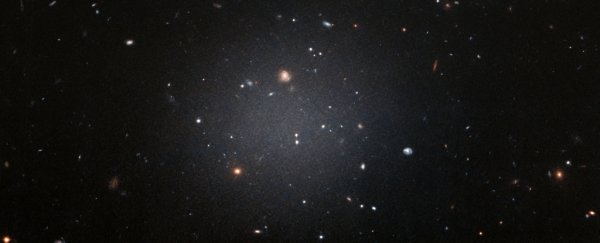Remember that time astronomers discovered a galaxy with no dark matter? Well, they're back. They've found a second one, and it actually bolsters the case for dark matter's existence.
As the second galaxy astronomers have found without any dark matter, the new finding - named NGC 1052-DF4 (DF4 for short) - confirms that the first discovery, NGC 1052-DF2 (yep, DF2 for short), was not a mistake.
Upon its discovery, DF2 was actually a huge surprise, and threw a pretty hefty spanner in our current ideas about galaxy formation and dynamics, because dark matter is a vital part of our understanding of galaxies.
The strange stuff is currently undetectable even to our best instruments, but we know that there is something out there, some invisible mass, increasing the gravitational forces at play in galaxies. In the Milky Way, for instance, the velocity of the outer rim of the galaxy is much faster than it would be if it was only affected by detectable matter.
In some galaxies, there seems to be more dark matter than normal matter; and, until the discovery of DF2, it had been thought that dark matter is not just a component, but a requirement for galaxies to form in the first place.
So that initial paper attracted some criticism - and even some doubts among the team.
"If there's one object, you always have a little voice in the back of your mind saying, 'but what if you're wrong?'," said astronomer Pieter van Dokkum of Yale University.
"Even though we did all the checks we could think of, we were worried that nature had thrown us for a loop and had conspired to make something look really special whereas it was really something more mundane."
Then, they found DF4. Like DF2, it's an ultra-diffuse galaxy - quite large, spread-out, and faint to observe. These objects are about the size of the Milky Way, but with 100 to 1,000 times fewer stars, so they can be pretty hard to see.
Both galaxies have also been associated with the elliptical galaxy NGC 1052, about 63 million light-years away in the constellation of Cetus.
And like DF2, DF4 seems to be completely lacking in dark matter. Using the Keck Observatory's Low Resolution Imaging Spectrometer (LRIS), the astronomers tracked the orbital motion of seven dense clusters of stars called globular clusters. Their velocity turned out to be consistent with the gravitational effect of the mass of the galaxy's estimated normal matter.
"Discovering a second galaxy with very little to no dark matter is just as exciting as the initial discovery of DF2," van Dokkum said.
"This means the chances of finding more of these galaxies are now higher than we previously thought. Since we have no good ideas for how these galaxies were formed, I hope these discoveries will encourage more scientists to work on this puzzle."
The team also conducted further research to confirm the previous results for DF2. Using the W. M. Keck Observatory's powerful Keck Cosmic Web Imager (KCWI), they tracked the orbits of 10 globular clusters. The velocity of these was also consistent with a lack of dark matter.
And because these galaxies are so peculiarly dark matter-free, they are actually a supporting argument for its existence - because they prove that normal matter can exist separately.
There are, of course, alternative hypotheses to dark matter theory; but under those, the existence of these galaxies becomes a more difficult problem, the researchers said.
As for why these galaxies lack dark matter, that remains unsolved. Did they have it and lose it somehow? Did they form without it from gas ejected by NGC 1052? It's hard to say - but perhaps if we discover even more galaxies like this, we could start piecing it together.
"We hope to next find out how common these galaxies are and whether they exist in other areas of the universe," said astronomer Shany Danieli of Yale University.
"We want to find more evidence that will help us understand how the properties of these galaxies work with our current theories. Our hope is that this will take us one step further in understanding one of the biggest mysteries in our universe - the nature of dark matter."
The research has been published in The Astrophysical Journal Letters here and here.
